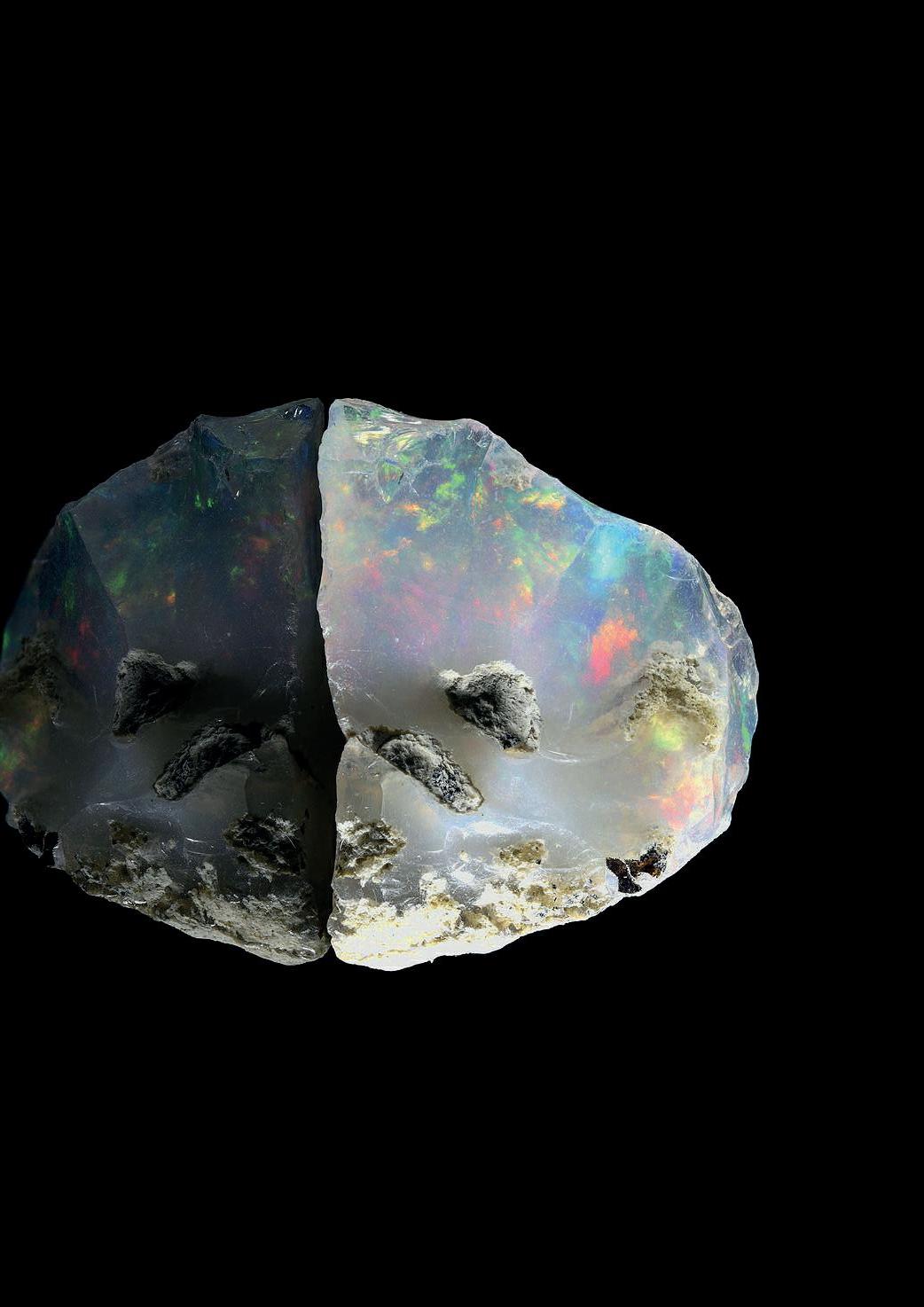
15 minute read
Nature
Opulent
PRECIOUS OPAL IS COUNTED AMONG THE BEST OF GEMSTONES, BUT IT IS QUITE UNLIKE ANY OF THE OTHERS IN THAT IT IS NOT A CRYSTAL
Advertisement
Ordinary opal is in fact a very So how did the opal acquire a dismal common mineral, and is a solid jelly reputation for ill-fortune? In with little or no crystalline France, you never see opals in structure. Precious opal, however, has a jewellers’ windows, and the very special structure of tiny spheres about jewellers I have chatted to say they 500 nanometers in diameter, stacked in a will set an opal if asked, but would 3-dimensional lattice. This measurement never willingly handle such an is of the same order of size as the unlucky gem. In England also, wavelenghts of visible light, so this there is a suspicion hanging structure has the power to split white light over opals, and many people into its spectral colours. The result is that refuse to own one. a good precious opal will show flashes of The non-crystalline nature ofintense colour when it is moved in a strong opal means that itswhite light. The colour seen depends upon properties are very differentthe exact size of the spheres. from other precious As you can imagine, the conditions for this gemstones. It is noticeably structure to form are very rare, and softer even than emerald, precious opal is hard and so can scratch if worn to find. In antiquity continuously. It most of the stones came from the east, and were fabulously They were regarded as bringers of good contains water in its structure, and is thus susceptible costly. It is told that a fortune and protection to changes in Roman called Nonius, who had a beautiful against plague humidity, so some opals can actually opal the size of a swell or contract in walnut, treasured it so much that when wear. This means that the stone’s Mark Anthony tried (rather aggressively) setting must be flexible enough to to buy it to give to Cleopatra, Nonius fled Rome, leaving his position and his wealth allow for this, or the stone can crack or fall out spontaneously. behind, just to protect his opal. Early jewellers were unaware of Opals were prized as second only in value and prestige to emeralds in the ancient world. They were regarded as bringers of good fortune and protection against plague. Napoleon 1st gave a splendid opal to Josephine. It showed predominately red fire, and was probably the first opal to be given a name: The Burning of Troy (L’Incendie du Troie). Sadly, this opal is now lost. the opal’s special requirements, and there are many stories about very expensive opals being ruined in setting. This would result in a financial loss, but if you were setting an opal that belonged to the king you could lose your head as well! So it is generally agreed in France that the jewellers got together to spread the rumour that opals were accursed gems, to avoid having to work on them. This may have
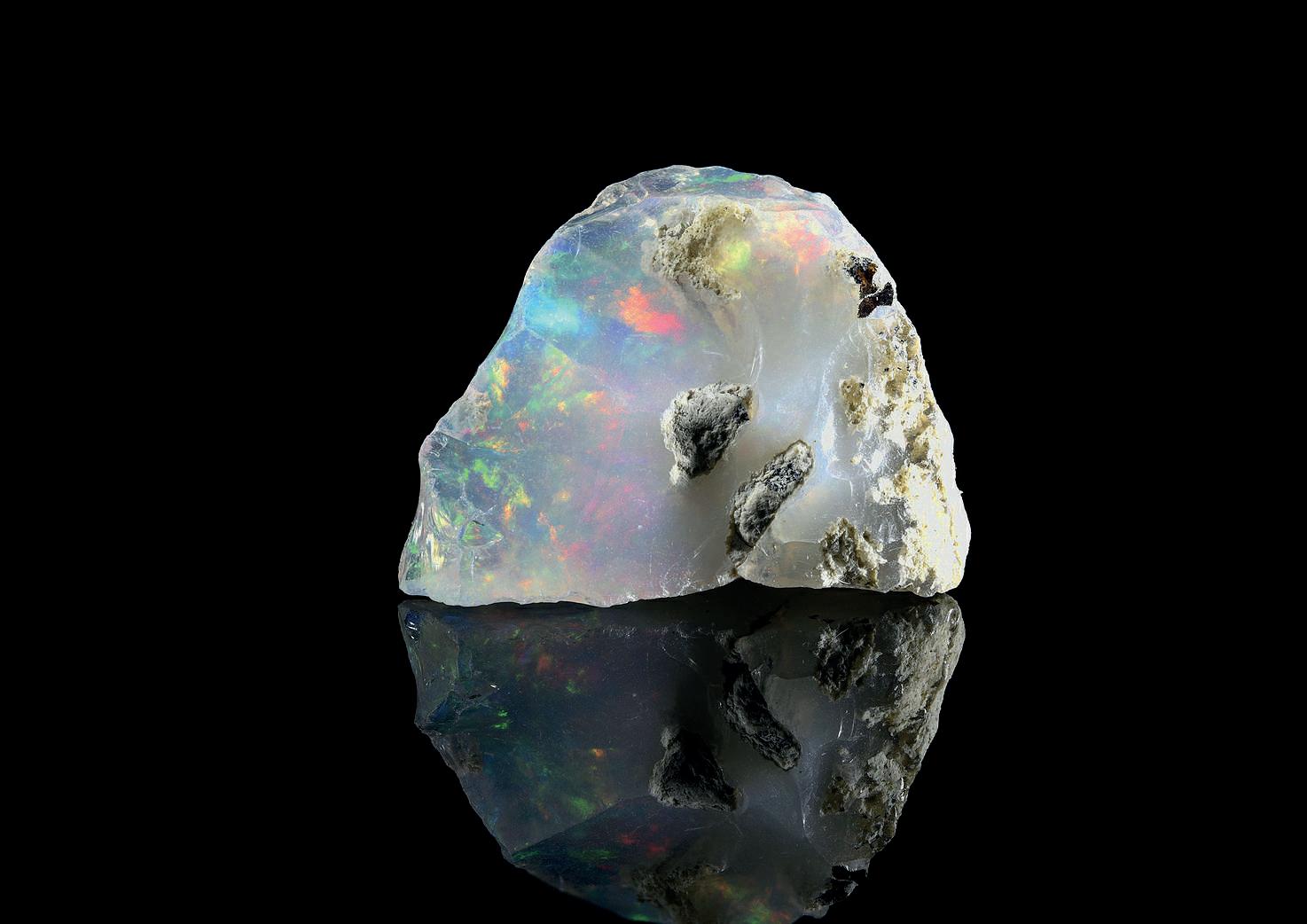
A rough boulder of white, semi-transparent precious opal, showing good colour-patches

By Mike George
Mike George is our regular contributor on wildlife and the countryside in France. He is a geologist and naturalist, living in the Jurassic area of the Charente
appealed to English unknown throughout history, so their jewellers also. beauty could be attributed to witchcraft. Alfred, Lord Tennyson, of all people, also helped in the downplaying of opals. He was a very popular author in the 19th century (although his style is too classical for modern taste) and his books were When I was first learning about gemstones, the textbooks were very vague on the reason for the play of colour, the chief explanation being that minute cracks and planes within the structure gave rise to the spectral effect, much as a film of oil on water gives rainbow colours. It was only the invention of the Scanning Electron Microscope that enabled scientists to look into the structure of the opal and find out the true cause of the colour-play. eagerly read. He Empress Eugenie, wife of Napoleon III, wrote a book was terrified of opals, and would have called “Anne of nothing to do with them. However, Geierstein”, in Eugenie’s friend Queen Victoria loved which a rather them. The opal fields of Australia were spooky character discovered in the mid-1800s, and the called Lady stones were becoming available. In Hermione, addition to the normal white opals, black thought to be an and transparent opals were discovered, enchantress, and Victoria was in a unique position to always wears an acquire prize specimens. Her collection opal in her hair. became world-famous. One day, a few drops of Holy Water fall upon it. The opal gives a vivid flash, then loses all its colour. Lady Hermione collapses, and her body dwindles to a heap of ashes. Opals occur in several places throughout the world, but Australia is the most famous. In one town called Coober Pedy, the opals are dug from pits and tunnels underground, and indeed it is so hot there that old workings are turned into houses, and the It was only the invention of the Scanning Electron Microscope that enabled scientists to look into the structure of the opal It is very unlikely that population spends its day underground. Tennyson set out to wreck the The town’s name is supposed to be an reputation of opals, but such Aborigine phrase for “White man in was his popularity that his story a hole”! had that effect, and it is still not fully restored. For all its bad press, Opal is the birthstone for October. Fortunately, many people
The other problem with opals is that love opals and the trade in them is the reason for their play of colour was still strong.


An exquisite opal and diamond ring, with a beautiful water-opal displaying a splendid harlequin colour pattern
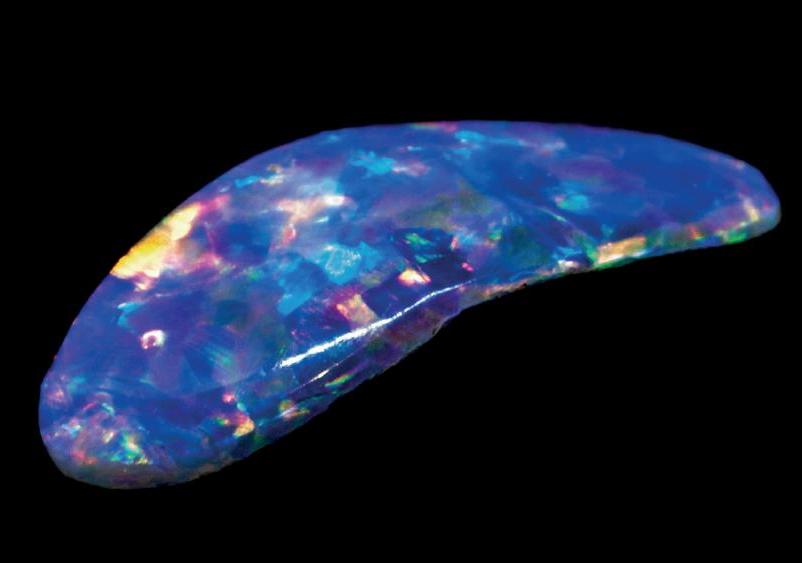
A vein of semi-black opal cutting through iron-rich sandstone When buying an opal, you must be aware of the existence of doublets and triplets. Here, small pieces of goodcolour, usually black, opal are sliced very thinly and then pasted onto thicker slices of non-precious opaque opal, known as “Potch”. The potch serves to give strength to the “doublet”, which is then carefully shaped and polished so that the precious opal layer shows up well and the potch is hidden. These can be quite spectacular-looking, but of course, an inspection of the edges and back of the stone should reveal the truth very quickly. Always be wary of opals set so that the back is hidden. Doublets, if well-made and with good, colourful opal, are acceptable as jewellery but of course will never have the beauty and depth – or value - of solid opal. If the opal layer is very thin and fragile, a thin third layer of transparent quartz may be pasted over the opal layer. This is called a triplet, and is virtually worthless financially, though it may be quite attractive. In the great rush to synthesize gemstones in the middle of the last century, one goal, once the mechanism of the colour-play was understood, was to synthesize opal. Eventually a few experimenters claimed to have succeeded, and a few synthetic opals appeared on the market. However, they were always not quite right to the eye of an experienced opal enthusiast. The patches of colour were often described as looking like lizard-skin, and everything was just a bit wrong. It also involved time-consuming and expensive techniques, and a synthetic opal of any quality might well have cost more to make than a natural stone would cost. Eventually the synthesizers gave up, and to the best of my knowledge, no-one is now making synthetic opal.
Non-precious opal or potch. Useful for strengthening precious opal
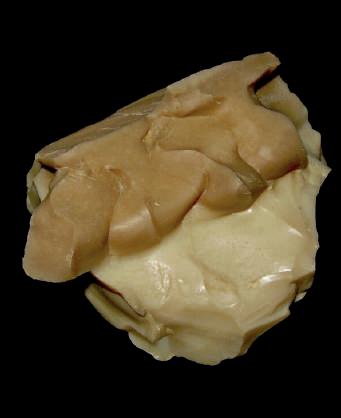
Veins of precious white opal invading the local rock

A stunning black opal, with rare yellow colour-play, from Lightning Ridge, Australia. Only the best rough stones are given names. This is the Harlequin Prince. 215.85 carats
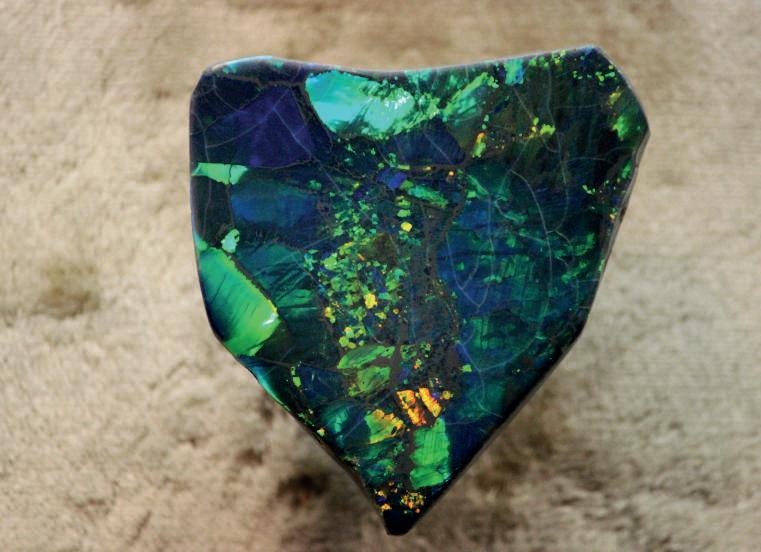
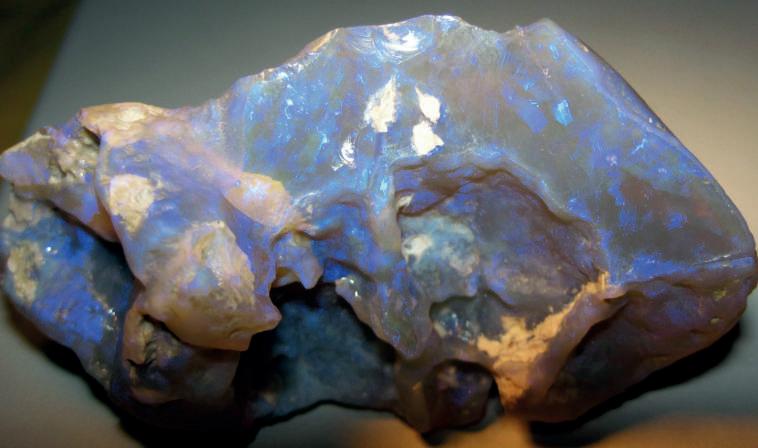
A beautiful unpolished black opal with an unusual blue colour-play
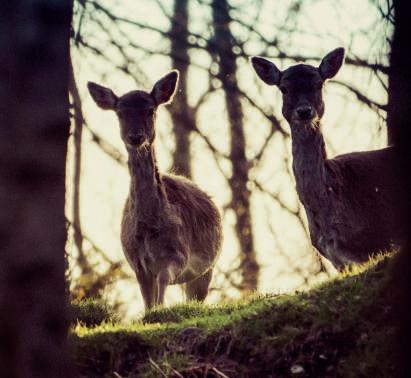
"Harlequin Prince Opal" by greyloch is licensed under CC BY-SA 2.0
Australia) 1" by James St. John is licensed under CC BY 2.0 "Precious opal (Lightning Ridge, New South Wales, There may still be butterflies about. The usual hardy over-winterers – Red Admiral, Peacock, Small Tortoiseshell –should be in evidence on warmer, sunny days, should we get any! In late August the Comma butterflies were very numerous. You may find some overwintering moths as well – the Herald Moth is often found in odd, cool corners. I have seen these moths hibernating in caves and old mine-adits with frost coating their wings. Animals that store food for the winter, such as squirrels and mice, will still be busy, although the peak of their activities will have been in October. Hedgehogs and other hibernating species will be searching out good hibernacula and topping up their energy supply for the long sleep. In this connection, as you raid your woodpile for fuel, take care not to disturb any hibernators, to whom a log-pile is a mansion. I say it every autumn, please check your bonfire stack, if it has been around for a while, and start your bonfire elsewhere, carrying the material to be burned and feeding the new fire. This helps to control the bonfire and also avoids incinerating any hapless hibernators. Your garden will be covered with leaves just about now. Many gardening advisers will tell you to sweep them up and dispose of them. I just leave them. Much less hard work, and the leaves act as cover for foraging small mammals and protect the tree-roots and grass from frost to some extent. Also as they rot down they put back nutrients into the soil. Deer, partridges and wild boar are trying to keep themselves fed, and also keep their heads down as the hunting season gets under way. Take extra care if you walk in rural areas, especially wooded ones. Keep your dog on a lead, and wear something bright-coloured. And do remember, it has been said that the partridge is a bird bred to be daft enough for an English aristocrat to outwit it. They behave erratically if you drive up to them. Give them time.
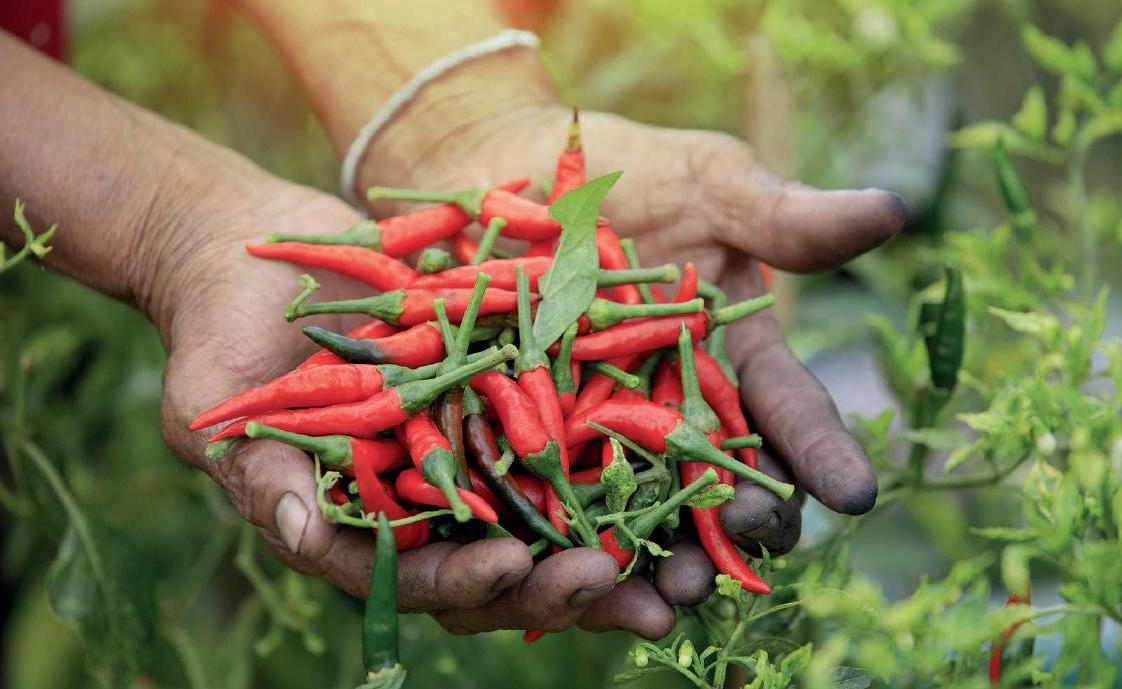
Handle with care - the juice of these chillies can hurt severely if you are not careful
It Ain’t Half Hot, Mum!
NOW SUMMER IS OVER, OUR THOUGHTS TURN TO WARM COMFORT FOOD. A CURRY GOES DOWN WELL ON A COLD EVENING, BUT WHAT ON EARTH PUT THE HEAT IN THE CHILLI-PEPPER THAT FLAVOURS IT?
America. Since its discovery, it has spread to all parts of the world, and in some cultures (e.g. India) has become a serious component of the national cuisine. However, the champion chilli-consumers are the Mexicans, who eat roughly one chilli per person per day! There are three main species of chilli: Capsicum annuum, C. frutescens and C. chinense. They all have hot and weakstrength members, and cross-breeding has been performed over the years, so the species tends to be regarded more as a complex than three separate groups. Practically all chilli peppers you will meet stem from one of these three species.
Self-defence
The heat in a chilli pepper comes from an alkaloid called capsaicin (pronounced capSAY-sin). It is concentrated in the chilli in the tissue surrounding the seeds. Contrary to popular belief, there is not much capsaicin in the seeds themselves or in the flesh of the fruit, and what there is has seeped in from the seed-membrane. The removal of the seeds also scrapes out this membrane, which is why a de-seeded chilli is less hot. Unlike many plant defensive alkaloids, capsaicin is not fatal in the quantities ordinarily consumed, but it has the power to bind to certain nerve-receptors in our
Mike George is our regular contributor on wildlife and the countryside in France. He is a geologist and naturalist, living in the Jurassic area of
The chilli plant is native to South
the Charente
By Mike George mouths which normally warn of the presence of excessive heat. Normally, these receptors send a warning when they encounter temperatures in the upper 40s centigrade or above, at which point cell damage can occur. The capsaicin fools the receptor into firing at a much lower temperature, so you get the burning sensation without the associated cell-damage. Now in most mammals, this means they back off from the plant and leave it alone. When a mammal eats a chilli fruit, it will chew many of the seeds and destroy them, and its digestive process is too robust for any undamaged seed to survive. In fact,
The Chinese Tree Shrew can actually eat chillies because it does not know they are hot
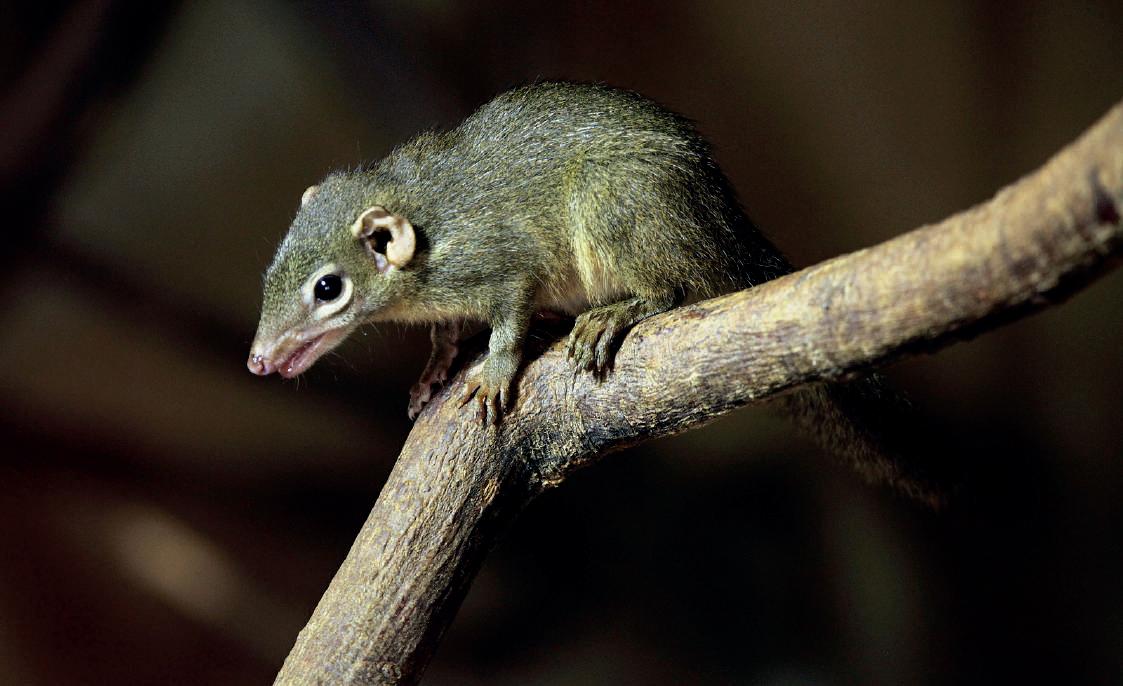
Wilbur Lincoln Scoville, creator of the "Scoville Organoleptic Test", now standardized as the Scoville scale

there are only two mammals that actively seek out chilli fruit to eat; Man, who enjoys the flavour, and a curious Chinese Tree-shrew which does not have the necessary pain receptors for the capsaicin to bind to, so does not know they are hot. However, capsaicin can also bind to other pain receptors in mammal tissues other than those in the mouth, and can give rise to some serious pain. All the mucous membranes, the skin and the eyes can be so affected. Even the stomach lining is not immune. This has given rise to the use of capsaicin as a weapon. The Aztec Indians learned to use a spray of capsaicin to ward off attack, and over the centuries this has been refined into the pepper sprays used by law enforcement officers to this day. In some countries, even civilians may so arm themselves, but many countries forbid this by law.
Are other animals sensitive?
Birds can eat chilli fruit with impunity. They, like the Chinese Squirrels, lack the receptors for capsaicin, but this is no problem to the plant. Their digestive system is ideal for propagating seeds. They don’t chew; their stomach acids are powerful enough to soften the outer casing of the seed without further damaging it, and of course they drop the seeds wherever they defecate. Thus the plant wins. Interesting to speculate on how that particular symbiosis evolved. But the capsaicin has another purpose. Bugs, which bore into the fruit with sucking mouthparts to gain nourishing Carolina Reaper, a cultivar of C. chinense. fluids, seem to dislike capsaicin, and the This scored 1.5 million - 2.5 million SHU. hotter the chilli, the less they will attack the fruit. Also, moulds and fungus that will attack the seeds in damp, humid environments are also discouraged by the presence of capsaicin. However, producing capsaicin requires the plant to expend energy it might need for other purposes, and one chilli, Capsicum chacoense, has evolved to cope with this. Those of its species that happen to grow in damp places where mould and bugs abound produce capsaicin; those in dry, hot environments do not. This is very useful for scientists, as Should you over-indulge in a vindaloo, or accidentally chew on a whole hot chilli, what can you do? Drinking water is only a temporary relief. Capsaicin is not watersoluble, so when the cooling effect of the water passes, the pain returns. It is, however, soluble in oil, so milk, yoghurt or some easilyassimilated oily fluid should help, especially if it has fresh chopped mint in it, whose oil will also bind to the receptors and calm them. Why do you think raita was invented? In some countries, even civilians may so arm themselves, but many countries forbid this by law they can compare the effect of capsaicin or As for using chilli in your own cooking, no capsaicin in fruit that they know are like any other ingredient, it has to be otherwise exactly the same. handled with care. You can ruin a dish How strong is my chilli? with too much salt! However, there are things you can do to rescue the situation The heat of a chilli is referred to by with chilli. I once made some stock, and to Scoville heat units (SHU). In about 1912, give it some zing I put in some chilli. The Wilbur Scoville, an American pharmacist, trouble was, I could only find a bottle of devised a plan whereby the solution dried Bird’s-eye chilli peppers, so I put in extracted from a chilli would be diluted in about 10, not realizing that although tiny, sugar water until the capsaicin could no they are HOT. When I tasted the stock, it longer be detected by a team of trained was like paint-stripper. I thought it was a tasters. The Scoville Unit is the number of goner, but my wife, resourceful girl, equal-volume dilutions required. The strained it off into another saucepan and lowest is, of course, zero, as exemplified by threw in half-a-dozen peeled raw potatoes. the bell-pepper. The jalapeño pepper After about an hour’s simmering, the stock scores 2,500 – 8,000 SHU. For many was left with a pleasant zing and the years the Scotch bonnet pepper was potatoes had acquired a chilli tang that considered the most potent, but in 2013 made them perfect for roasting, sautéing the accolade of hottest chilli went to the or any other use for a boiled potato.










